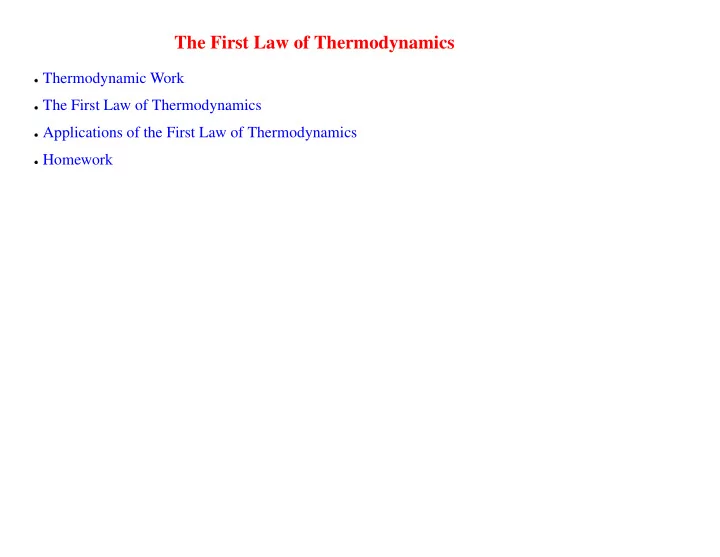

� � � � The First Law of Thermodynamics Thermodynamic Work The First Law of Thermodynamics Applications of the First Law of Thermodynamics Homework
✓ ✁ ✏ � ✟ ✁ ✄ ☎ ✑✒ ✁ ✄ ✑ ✒ � ✒ ✄ ✌ ✆ ✁ ✓ ☎ ✒ ✁ ✄ ✁ ✂ ☎ ✆ ✑ ✁ ✎ ☎ ✄ ☛ ✞ ✁ ✁ ✄ ✆ ✁ ✞ ✂ ✁ ✂ ☎ ☞ ✆ � ✎ ✏ ✠ ☞ ✆ ✁ Thermodynamic Work Consider a piston filled with a gas and sealed with a movable piston as shown below If the gas is compressed quasi-statically (slowly enough to allow the system to remain in thermal equilibrium at all times), the differential element of work done on the gas as the piston moves a distance is ☎✝✆ ✟✍✌ ✟✡✠ where is the pressure of the gas and is the area of the piston. Note that the volume of the cylinder decreases by an amount , so we can write the differential change in the volume of the cylinder , and the differential element of work done on the gas as
✘ ✛ � ✔ ✕ ✔ ✔ ✖ ✥ ✗ � ✙ ✚ ✛ ✜ Thermodynamic Work II The total work done on the gas as its volume changes form to is ✢✤✣ The work done on the gas is the negative of the area under the curve on a PV diagram
� Path Dependence of Thermodynamic Work The work done on a gas as it is taken from an initial state to a final state depends on the path between these states
✂ ✁ ✫ ✂ ✦ ✧ ✢★✩ � ✧ ☎ ✢★✩ ☎ ✁ ✪ ✫ ✁ � ✪ ★✩ ✢ ✦✧ ✢★✩ ☎ ✪ ✫ ✂ � � � ✦ ✧ The First Law of Thermodynamics The change in internal energy of a system is equal to the heat added to the system plus the work done on the system Statement of conservation of energy for thermodynamic systems Q and W separately depend on the path taken does not depend on the path, but only on the initial and final states, so we call a state variable The first law can be expressed in differential form as
Example 1 Suppose 200 J of work are done on a system and 70 cal are extracted from the system. What is the change in internal energy of the system?
✬ ✭ ✮ ✮ ✮ Example 2 A piston-cylinder arrangement contains 1.00 kg of liquid water which is converted to steam by boiling at standard atmospheric pressure. The volume changes from an initial value of 1.00 10 m as a liquid to 1.671 m as steam. (a) How much work is done on the system during the process? (b) How much energy is transferred as heat during the process? (c) What is the change in internal energy of the system during the process?
✴ ✘ ✥ ✢ ✛ ✜ ✛ ✶ ✣ ✙ ✔ ✘ ✥ ✣ ✢ ✛ ✜ ✛ ✶ ✙ ✔ ✙ ✗ ✵ ✘ ✱✲ ✕ ✰ ✯ ✳ ✘ ✗ ✘ ✣ � ✸ ✕ ✔ ✙ ✖ ✔ ✷ � ✘ ✵ ✘ ✙ ✘ ✘ ✴ ✳ ✯ ✰ ✕ ✱✲ ✘ ✗ ✗ � ✘ ✳ ✕✱✲ ✯ ✰ ✕✱ ✲ ✘ ✳ � ✯✰ ✗ Applications of the First Law of Thermodynamics Cyclic process – Process that begins and ends at the same state – Since internal energy is a state variable – From the first law – The net work done per cycle equals the area enclosed by the path representing the pro- cess on a PV diagram Adiabatic process – No heat enters or leaves the system Q = 0 – From the first law we have – Free expansion is a unique adiabatic process in which and therefore Isobaric process – Process that occurs at constant pressure – Isovolumetric process – Process occurs at constant volume – From the first law we have
❁ ✛ ✘ ✙ ✹ ✺ ✻ ✶ ✛ ✜ ✛ ✛ ✘ � ✙ ✹ ✺ ✻ ✾✿ ❀ ✛ ✜ ✛ ✢ ✔ ✥ ✣ ✙ ✯✰ ✕✱ ✲ ✘ ✳ ✴ ✢ ✘ ✗ ✗ ✘ ✙ ✶ ✛ ✜ ✛ Applications of the First Law of Thermodynamics II Isothermal process – Process that occurs at constant temperature – Since the internal energy of an ideal gas is a function of temperature only, for an ideal gas during an isothermal process – From the first law we have – ✢✽✼
� � Homework Set 5 - Due Mon. Jan. 19 Read Sections 17..4 - 17.6 Do problems 17.18, 17.22, 17.23, 17.27 & 17.28
Recommend
More recommend